

Witchcraft: A beginners Guide part 1.mp4.
Basic Altar Setup - Setting Up Your Magical Altar. Tools of the Craft. When people first discover Paganism or Wicca, they often rush to go buy every single magical tool they can find.
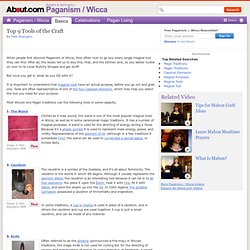
After all, the books tell us to buy this, that, and the kitchen sink, so you better hustle on over to Ye Local Wytchy Shoppe and get stuff! But once you get it, what do you DO with it? It is important to understand that magical tools have an actual purpose, before you go out and grab one. Tools are often representative of one of the four classical elements, which may help you select the tool you need for your purpose. Most Wiccan and Pagan traditions use the following tools in some capacity. 1. Image © Patti Wigington 2008. Witchcraft, Pagan & Wiccan: My Wiccan Tools. Witchcraft, Pagan & Wiccan: The Importance Of Wiccan Tools. How Do I Become A Witch/Wiccan/Pagan? Wicca Beliefs and Practices.
There are a wide variety of beliefs and practices in modern day Wicca.
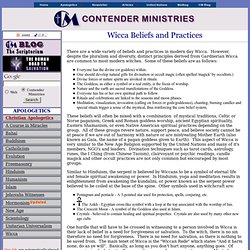
However, despite the pluralism and diversity, distinct principles derived from Gardnerian Wicca are common to most modern witches. Some of these beliefs are as follows: Everyone has the divine (or goddess) within. One should develop natural gifts for divination or occult magic (often spelled 'magick' by occultists.) Divine forces or nature spirits are invoked in rituals. These beliefs will often be mixed with a combination of mystical traditions, Celtic or Norse paganism, Greek and Roman goddess worship, ancient Egyptian spirituality, Eastern Shamanism, or even Native American spiritual practices depending on the group. Wicca: A Guide for the Solitary Practitioner - Scott Cunningham [9780875421186] - £7.44 : Jazmin-Books!, A Whole World Of Reading. Witchcraft, Pagan & Wiccan: Pagan Reading Recommendations.
Goddess and God Names - Life As A Wiccan. Various Wiccan Traditions. Various Wiccan Traditions Gardnerian Wicca A retired British civil servant named Gerald B.
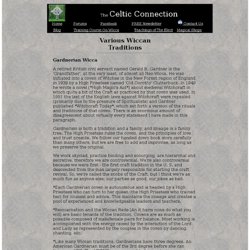
Intro to Pagan Paths. I’ve been searching for a site that provides an overview of the variants of paganism most widely practiced today, or at least most widely known.
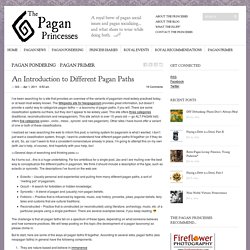
The Wikipedia site for Neopaganism provides great information, but doesn’t provide a useful way to categorize pagan faiths — a taxonomy of pagan paths, if you will. There are some classification systems out there, but they don’t appear to be widely used. Types of Paganism? Types of Pagan Faiths. A lot of times many pagan faiths are lumped together under Wicca.
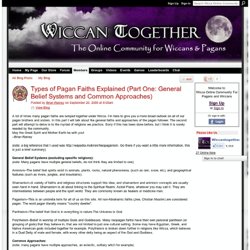
I'm here to give you a more broad outlook on all of our pagan brothers and sisters. In this part I will talk about the general faiths and approaches of the pagan follower. The second part will attempt to delve in to the myriad of religions we practice. Sorry if this has been done before, but I think it is sorely needed by the community. May the Great Spirit and Mother Earth be with you! Ceremonial magic. Ceremonial magic , also referred to as high magic and as learned magic , [ 1 ] is a broad term used in the context of Hermeticism or Western esotericism to encompass a wide variety of long, elaborate, and complex rituals of magic .

It is named as such because the works included are characterized by ceremony and myriad necessary accessories to aid the practitioner. It can be seen as an extension of ritual magic, and in most cases synonymous with it. Popularized by the Hermetic Order of the Golden Dawn , it draws on such schools of philosophical and occult thought as Hermetic Qabalah , Enochian magic , Thelema , and the magic of various grimoires .
Renaissance magic [ edit ] The term originates in 16th century Renaissance magic, referring to practices described in various Medieval and Renaissance grimoires and in collections such as that of Johannes Hartlieb . Revival [ edit ] Francis Barrett [ edit ] Thelema.org. H.O.O.R. > Home. Aleister Crowley. After an unsuccessful attempt to climb Kanchenjunga and a visit to India and China, Crowley returned to Britain, where he attracted attention as a prolific author of poetry, novels, and occult literature.
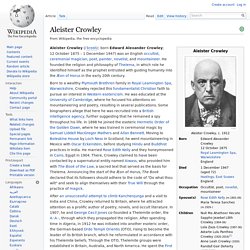
In 1907, he and George Cecil Jones co-founded a Thelemite order, the A∴A∴, through which they propagated the religion. After spending time in Algeria, in 1912 he was initiated into another esoteric order, the German-based Ordo Templi Orientis (OTO), rising to become the leader of its British branch, which he reformulated in accordance with his Thelemite beliefs. Through the OTO, Thelemite groups were established in Britain, Australia, and North America.
He spent the First World War in the United States, where he took up painting and campaigned for the German war effort against Britain, later revealing that he had infiltrated the pro-German movement at the behest of the British intelligence services. Early life[edit] Youth: 1875–94[edit] Cambridge University: 1895–98[edit] A Thelemic Resource Page. Order of Thelemic Knights and The Thelemic Gnostic Church of Alexandria. Ordo Templi Orientis (O.T.O.) US Grand Lodge » Ordo Templi Orientis. Kemetism. Kemetism (also Kemeticism ; both from km.t , the native name of Ancient Egypt ) is a term for Egyptian neopaganism , i.e. neopagan revivals of Ancient Egyptian religion which developed in the United States from the 1970s onwards.
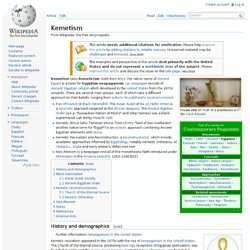
There are several main groups, each of which take a different approach to their beliefs, ranging from eclectic to polytheistic reconstructionist . Pan-Africanist or black nationalist : The Ausar Auset of Ra Un Nefer Amen is a syncretic approach targeted at the African diaspora . The Ancient Egiptian Order (a.k.a. "Nuwaubian Nation of Moors" and other names) was a black supremacist cult led by Malachi York . Kemetic Wicca (also Tameran Wicca , from t3 mry "land of two riverbanks", another native term for "Egypt") is an eclectic approach combining Ancient Egyptian elements with Wicca .
History and demographics [ edit ] Symbol of kemetism, Ankh Kemetic revivalism appeared in the 1970s with the rise of neopaganism in the United States . Black nationalism [ edit ] Neo-Druidism. Neo-Druidism or Neo-Druidry, commonly referred to as Druidry by many adherents,[1][2][3] is a form of modern spirituality or religion that generally promotes harmony and worship of nature, and respect for all beings, including the environment.

Many forms of modern Druidry are Neopagan religions, whereas some are instead seen as philosophies that are not necessarily religious in nature.[4][5] Originating in Britain during the 18th century, Druidry was originally a cultural movement, only gaining religious or spiritual connotations in the 19th century. The core principle of Druidry is respect and veneration of nature, and as such it often involves participation in the environmental movement. Another prominent belief amongst modern Druids is the veneration of ancestors, particularly those who belonged to prehistoric societies. Beliefs[edit] A Druid symbol Nature-centered spirituality[edit] Neo-druidism. Neo-druidism or neo-druidry , commonly referred to as Druidism or Druidry by its adherents [ 1 ] [ 2 ] [ 3 ] is a form of modern spirituality or religion that generally promotes harmony and worship of nature, and respect for all beings, including the environment.

It is considered to be a Neopagan faith by some adherents, along with such religions as Wicca and Asatru , though "some assert that Druidry is not a religion at all, not even necessarily a spirituality, but simply a philosophy of living" [ 4 ] that can be adhered to by followers of any religion or by atheists . Originally inspired by 17th-, 18th-, and 19th-century Romantic movements, modern Druidism was based upon theories about the Iron Age Celtic druids which are no longer considered to be historically accurate.
Full article ▸ Neo-Druid movement. Hellenic Polytheistic Reconstructionism. Hellenism (Greek: Ἑλληνισμός), or the Hellenic Ethnic Religion (Ἑλληνικὴ Ἐθνικὴ Θρησκεία), also known as Dodekatheism (Δωδεκαθεϊσμός), Olympianism, or Hellenic Neopaganism, refers to various reconstructionist movements that revive ancient Greek religious practices, emerging since the 1990s. Hellenic Reconstructionism exists in Greece and in other countries. Germanic neopaganism. The hammer Mjöllnir (literally "smasher", "smashing power") is one of the primary symbols of Pagan religions; pendants are commonly worn amongst adherents. The Witch of Forest Grove. The Call from the Great Below Posted by Sarah on March 20, 2014 The Three who are in the earth, the Three who are in the air, the Three who are in the heavens, the Three who are in the great pouring sea.
Two years ago the old fairy doctor with her long white hair used the words translated from Scots Gaelic I too use in my rites to cast a protective caim. Animism. Specifically, animism is used in the anthropology of religion as a term for the belief system or cosmology of some indigenous tribal peoples,[5] especially prior to the development and/or infiltration of colonialism and organized religion.[6] Although each culture has its own different mythologies and rituals, "animism" is said to describe the most common, foundational thread of indigenous peoples' "spiritual" or "supernatural" perspectives.
The animistic perspective is so fundamental, mundane, everyday and taken-for-granted that most animistic indigenous people do not even have a word in their languages that corresponds to "animism" (or even "religion");[7] the term is an anthropological construct rather than one designated by the people themselves. Largely due to such ethnolinguistic and cultural discrepancies, opinion has differed on whether animism refers to a broad religious belief or to a full-fledged religion in its own right. Pagan Classification. WICCAN BELIEFS. It must be stressed that Wiccans have no supernatural being in their pantheon of deities who resembles the quasi-deity Satan found in Christianity and Islam. This belief was quite common among conservatives of other faiths. How to become a Wiccan or Witch. Pagan 101 - Becoming a Pagan FAQ. American Council of Witches - the Council of American Witches - The 13 Principles of Wiccan Belief.
The Pagan Religion: An Overview for the Curious and the Urban Pagan. Wiccan FAQ. Q. Do Paganism and Wicca Have Rules? - Rules of Magic - Laws of Wicca. Ten Things For Teens To Learn Besides Wicca. I know, it stinks. You finally sat down and had The Big Talk with your parents and they still won't let you practice Wicca in their house.